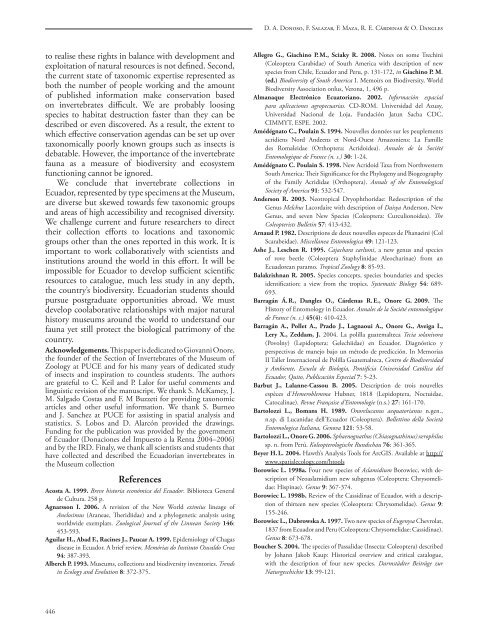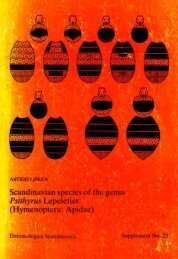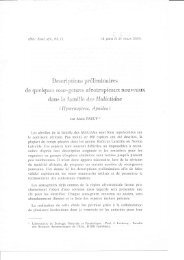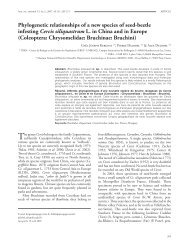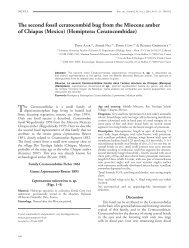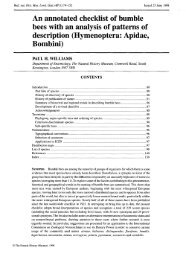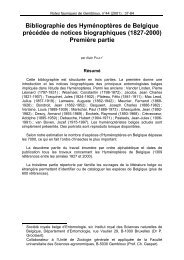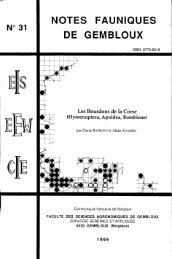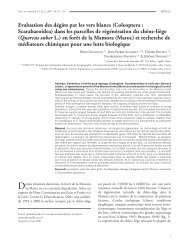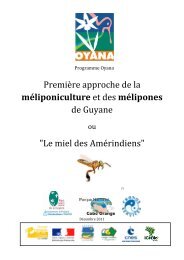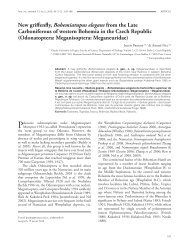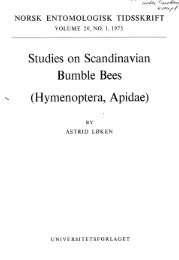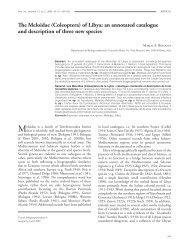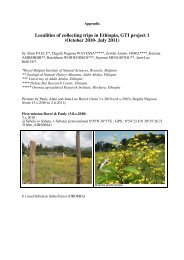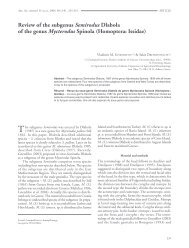ASEF 4-2009.indb - Laboratoire de Zoologie
ASEF 4-2009.indb - Laboratoire de Zoologie
ASEF 4-2009.indb - Laboratoire de Zoologie
You also want an ePaper? Increase the reach of your titles
YUMPU automatically turns print PDFs into web optimized ePapers that Google loves.
to realise these rights in balance with <strong>de</strong>velopment and<br />
exploitation of natural resources is not <strong>de</strong>fi ned. Second,<br />
the current state of taxonomic expertise represented as<br />
both the number of people working and the amount<br />
of published information make conservation based<br />
on invertebrates diffi cult. We are probably loosing<br />
species to habitat <strong>de</strong>struction faster than they can be<br />
<strong>de</strong>scribed or even discovered. As a result, the extent to<br />
which eff ective conservation agendas can be set up over<br />
taxonomically poorly known groups such as insects is<br />
<strong>de</strong>batable. However, the importance of the invertebrate<br />
fauna as a measure of biodiversity and ecosystem<br />
functioning cannot be ignored.<br />
We conclu<strong>de</strong> that invertebrate collections in<br />
Ecuador, represented by type specimens at the Museum,<br />
are diverse but skewed towards few taxonomic groups<br />
and areas of high accessibility and recognised diversity.<br />
We challenge current and future researchers to direct<br />
their collection eff orts to locations and taxonomic<br />
groups other than the ones reported in this work. It is<br />
important to work collaboratively with scientists and<br />
institutions around the world in this eff ort. It will be<br />
impossible for Ecuador to <strong>de</strong>velop suffi cient scientifi c<br />
resources to catalogue, much less study in any <strong>de</strong>pth,<br />
the country’s biodiversity. Ecuadorian stu<strong>de</strong>nts should<br />
pursue postgraduate opportunities abroad. We must<br />
<strong>de</strong>velop coolaborative relationships with major natural<br />
history museums around the world to un<strong>de</strong>rstand our<br />
fauna yet still protect the biological patrimony of the<br />
country.<br />
Acknowledgements. Th is paper is <strong>de</strong>dicated to Giovanni Onore,<br />
the foun<strong>de</strong>r of the Section of Invertebrates of the Museum of<br />
Zoology at PUCE and for his many years of <strong>de</strong>dicated study<br />
of insects and inspiration to countless stu<strong>de</strong>nts. Th e authors<br />
are grateful to C. Keil and P. Lalor for useful comments and<br />
linguistic revision of the manuscript. We thank S. McKamey, J.<br />
M. Salgado Costas and F. M Buzzeti for providing taxonomic<br />
articles and other useful information. We thank S. Burneo<br />
and J. Sanchez at PUCE for assisting in spatial analysis and<br />
statistics. S. Lobos and D. Alarcón provi<strong>de</strong>d the drawings.<br />
Funding for the publication was provi<strong>de</strong>d by the government<br />
of Ecuador (Donaciones <strong>de</strong>l Impuesto a la Renta 2004–2006)<br />
and by the IRD. Finaly, we thank all scientists and stu<strong>de</strong>nts that<br />
have collected and <strong>de</strong>scribed the Ecuadorian invertebrates in<br />
the Museum collection<br />
446<br />
References<br />
Acosta A. 1999. Breve historia económica <strong>de</strong>l Ecuador. Biblioteca General<br />
<strong>de</strong> Cultura. 258 p.<br />
Agnarsson I. 2006. A revision of the New World eximius lineage of<br />
Anelosimus (Araneae, Th eridiidae) and a phylogenetic analysis using<br />
worldwi<strong>de</strong> exemplars. Zoological Journal of the Linnean Society 146:<br />
453-593.<br />
Aguilar H., Abad F., Racines J., Paucar A. 1999. Epi<strong>de</strong>miology of Chagas<br />
disease in Ecuador. A brief review. Memórias do Instituto Oswaldo Cruz<br />
94: 387-393.<br />
Alberch P. 1993. Museums, collections and biodiversity inventories. Trends<br />
in Ecology and Evolution 8: 372-375.<br />
D. A. Donoso, F. Salazar, F. Maza, R. E. Cár<strong>de</strong>nas & O. Dangles<br />
Allegro G., Giachino P. M., Sciaky R. 2008. Notes on some Trechini<br />
(Coleoptera Carabidae) of South America with <strong>de</strong>scription of new<br />
species from Chile, Ecuador and Peru, p. 131-172, in Giachino P. M.<br />
(ed.) Biodiversity of South America I. Memoirs on Biodiversity, World<br />
Biodiversity Association onlus, Verona, 1, 496 p.<br />
Almanaque Electrónico Ecuatoriano. 2002. Información espacial<br />
para aplicaciones agropecuarias. CD-ROM. Universidad <strong>de</strong>l Azuay,<br />
Universidad Nacional <strong>de</strong> Loja, Fundación Jatun Sacha CDC,<br />
CIMMYT, ESPE. 2002.<br />
Amédégnato C., Poulain S. 1994. Nouvelles données sur les peuplements<br />
acridiens Nord An<strong>de</strong>ens et Nord-Ouest Amazoniens: La Famille<br />
<strong>de</strong>s Romaleidae (Orthoptera: Acridoi<strong>de</strong>a). Annales <strong>de</strong> la Société<br />
Entomologique <strong>de</strong> France (n. s.) 30: 1-24.<br />
Amédégnato C. Poulain S. 1998. New Acridoid Taxa from Northwestern<br />
South America: Th eir Signifi cance for the Phylogeny and Biogeography<br />
of the Family Acrididae (Orthoptera). Annals of the Entomological<br />
Society of America 91: 532-547.<br />
An<strong>de</strong>rson R. 2003. Neotropical Dryophthoridae: Re<strong>de</strong>scription of the<br />
Genus Melchus Lacordaire with <strong>de</strong>scription of Daisya An<strong>de</strong>rson, New<br />
Genus, and seven New Species (Coleoptera: Curculionoi<strong>de</strong>a). Th e<br />
Coleopterists Bulletin 57: 413-432.<br />
Arnaud P. 1982. Descriptions <strong>de</strong> <strong>de</strong>ux nouvelles especes <strong>de</strong> Phanaeini (Col<br />
Scarabeidae). Miscellanea Entomologica 49: 121-123.<br />
Ashe J., Leschen R. 1995. Cajachara carltoni, a new genus and species<br />
of rove beetle (Coleoptera Staphylinidae Aleocharinae) from an<br />
Ecuadorean paramo. Tropical Zoology 8: 85-93.<br />
Balakrishnan R. 2005. Species concepts, species boundaries and species<br />
i<strong>de</strong>ntifi cation: a view from the tropics. Systematic Biology 54: 689-<br />
693.<br />
Barragán Á. R., Dangles O., Cár<strong>de</strong>nas R. E., Onore G. 2009. Th e<br />
History of Entomology in Ecuador. Annales <strong>de</strong> la Société entomologique<br />
<strong>de</strong> France (n. s.) 45(4): 410-423.<br />
Barragán A., Pollet A., Prado J., Lagnaoui A., Onore G., Aveiga I.,<br />
Lery X., Zeddam, J. 2004. La polilla guatemalteca Tecia solanivora<br />
(Povolny) (Lepidoptera: Gelechiidae) en Ecuador. Diagnóstico y<br />
perspectivas <strong>de</strong> manejo bajo un método <strong>de</strong> predicción. In Memorias<br />
II Taller Internacional <strong>de</strong> Polilla Guatemalteca, Centro <strong>de</strong> Biodiversidad<br />
y Ambiente, Escuela <strong>de</strong> Biología, Pontifi cia Universidad Católica <strong>de</strong>l<br />
Ecuador, Quito, Publicación Especial 7: 5-23.<br />
Barbut J., Lalanne-Cassou B. 2005. Description <strong>de</strong> trois nouvelles<br />
espèces d’Hemeroblemma Hubner, 1818 (Lepidoptera, Noctuidae,<br />
Catocalinae). Revue Française d’Entomologie (n.s.) 27: 161-170.<br />
Bartolozzi L., Bomans H. 1989. Onorelucanus aequatorianus n.gen.,<br />
n.sp. di Lucanidae <strong>de</strong>ll’Ecuador (Coleoptera). Bollettino <strong>de</strong>lla Società<br />
Entomologica Italiana, Genova 121: 53-58.<br />
Bartolozzi L., Onore G. 2006. Sphaenognathus (Chiasognathinus) xerophilus<br />
sp. n. from Perú. Koleopterologische Rundschau 76: 361-365.<br />
Beyer H. L. 2004. Hawth’s Analysis Tools for ArcGIS. Available at http://<br />
www.spatialecology.com/htools<br />
Borowiec L. 1998a. Four new species of Aslamidium Borowiec, with <strong>de</strong>scription<br />
of Neoaslamidium new subgenus (Coleoptera: Chrysomelidae:<br />
Hispinae). Genus 9: 367-374.<br />
Borowiec L. 1998b. Review of the Cassidinae of Ecuador, with a <strong>de</strong>scription<br />
of thirteen new species (Coleoptera: Chrysomelidae). Genus 9:<br />
155-246.<br />
Borowiec L., Dabrowska A. 1997. Two new species of Eugenysa Chevrolat,<br />
1837 from Ecuador and Peru (Coleoptera: Chrysomelidae: Cassidinae).<br />
Genus 8: 673-678.<br />
Boucher S. 2004. Th e species of Passalidae (Insecta: Coleoptera) <strong>de</strong>scribed<br />
by Johann Jakob Kaup: Historical overview and critical catalogue,<br />
with the <strong>de</strong>scription of four new species. Darmstädter Beiträge zur<br />
Naturgeschichte 13: 99-121.


